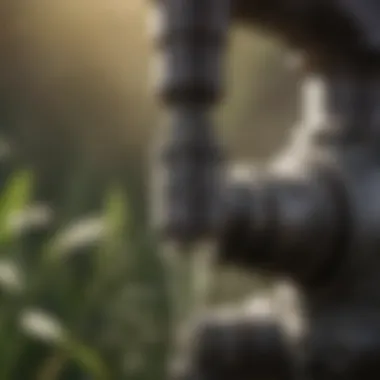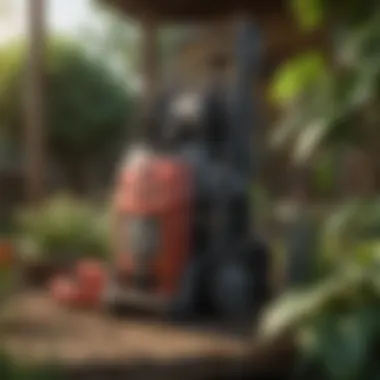Discover the Ideal Pump Sprayer for Gardening


Intro
Pump sprayers represent a critical tool in modern gardening and agricultural practices. Their design allows efficient application of liquids, such as fertilizers, herbicides, or insecticides. Understanding these tools, their approaches, and advancements is essential for achieving optimized gardening results.
Topic Overview
Definition and Importance
A pump sprayer is a device used for applying liquid substances to plants and soil. Unlike traditional watering cans, pump sprayers offer the ability to distribute liquids evenly over large areas. They enhance efficiency and save time, making them valuable for both small home gardens and large agricultural fields. These sprayers are especially useful for delivering solutions that can protect crops or quickly help them thrive.
The importance of choosing the right pump sprayer cannot be overstated. Each gardening task may require different amounts or types of liquid delivery. Hence, an appropriate sprayer ensures better results and promotes healthy plant growth while minimizing waste.
Brief History and Evolution
Historically, the art of spraying liquids in agriculture dates back centuries. Early techniques included the simple use of handheld vessels. However, as agricultural practices progressed, there was a growing need for more efficient and effective application methods.
The evolution of pump sprayers has seen innovations that have dramatically changed their efficiency. Modern sprayers now incorporate technology that allows for adjustable nozzles and pressure settings. This adaptability has made them popular among both professional farmers and home gardeners alike.
Key Techniques and Innovations
Sustainable Farming Practices
In recent years, the focus has shifted toward sustainable practices in gardening and farming. Pump sprayers have embraced this philosophy by enabling precise applications of organic pesticides and eco-friendly fertilizers. This allows gardeners to promote plant health without compromising the local ecosystem.
Advanced Agronomic Technologies
Technological advancements have brought forward digital pressure gauges and battery-powered sprayers. These innovations allow users to track and control the application of their products with more accuracy. Users can choose from multiple settings that match their garden's unique needs.
Practical Applications
Step-by-Step Guides
Selecting the right pump sprayer involves several considerations:
- Identify the types of liquid solutions you plan to use.
- Determine the size of the area you need to cover.
- Evaluate whether you require adjustable nozzles for varied applications.
- Check for ergonomic features if you plan to use it for extended periods.
This will ensure you choose a model that fits your gardening style.
Case Studies or Real-World Examples
Many gardeners have benefitted from understanding the various applications of pump sprayers. For example, a study demonstrated how a targeted sprayer type allowed farmers to reduce pesticide usage while maintaining crop health. This aligns with sustainable practices while also cutting down costs.
"Efficient application with precision tools leads to improved crop yields and reduced environmental footprint."
By embracing these tools in the right manner, gardeners can not only enhance their gardening effectiveness but also contribute positively to the environment.
Prelude to Pump Sprayers
Pump sprayers represent a pivotal tool in the arsenal of any gardener or farming enthusiast. Their significance is amplified in the realm of effective gardening practices, where precision and efficiency are paramount. These devices allow for controlled application of liquids, such as fertilizers, pesticides, or herbicides, thus aiding in the health and productivity of plants. Understanding pump sprayers is essential for both novice and experienced individuals aiming to optimize their gardening operations.


Definition of Pump Sprayers
Pump sprayers are manual or powered devices used to spray liquids in a controlled manner. They operate by creating pressure within a tank, which dispenses the liquid through a nozzle. The device can vary in size from small, handheld units to larger, more complex models suited for extensive gardens or farms. Key characteristics include tank capacity, nozzle types, and the method of pressurization.
Why Use a Pump Sprayer in Gardening
The advantages of using a pump sprayer are numerous and warrant consideration.
- Efficiency: Pump sprayers allow for quicker application over larger areas than traditional pouring methods.
- Control: With adjustable nozzles, users can modify the output to suit different tasks, whether it be a fine mist for delicate plants or a more forceful spray.
- Consistency: Regular use enables uniform application of products, promoting better results in pest control and fertilization.
- Ease of Use: Most pump sprayers are designed to be user-friendly, making them accessible for individuals of various skill levels.
According to research, the proper application methods can greatly enhance the effectiveness of gardening inputs, averting common issues such as uneven distribution and chemical runoff.
Types of Pump Sprayers
In understanding the various options available for pump sprayers, it is critical to grasp the distinct categories that can meet specific gardening needs. Each type has unique benefits and considerations, making it imperative for farmers and gardening enthusiasts to choose wisely. Selecting the right sprayer impacts not just efficiency but also the overall success of garden maintenance and upkeep. Let's delve into the key types of pump sprayers available in the market today.
Handheld Pump Sprayers
Handheld pump sprayers are often the first choice for many gardeners due to their simplicity and versatility. They are lightweight and designed for ease of use, making them suitable for smaller tasks, such as watering plants, applying pesticides, or distributing fertilizers. These sprayers typically have a capacity of around one to three gallons, which is sufficient for localized applications.
The primary advantage of handheld sprayers lies in their maneuverability. Gardeners can easily direct the spray without feeling exhausted. They often come equipped with adjustable nozzles, allowing for a variety of spray patterns, from fine mist to a concentrated stream. This adaptability makes them a great tool for various gardening tasks. However, they are not ideal for large areas due to limited tank capacity, which necessitates frequent refilling.
Backpack Pump Sprayers
Backpack pump sprayers are designed for larger tasks that require significant fluid storage. These sprayers can hold anywhere from four to six gallons of liquid, providing more extensive coverage without the need for constant refills. The backpack design distributes weight evenly across the user's back, allowing for longer use without discomfort.
These sprayers are highly effective for treating larger garden areas, including vegetable patches and flower beds. Backpack models generally include adjustable pressure settings as well, which lets users control the output easily. They can come with various nozzle options for specific tasks like targeted spraying or broader coverage. Operating a backpack sprayer does require physical effort, and the initial set-up time might be longer, but the benefits for serious gardeners are substantial.
Battery-Powered Pump Sprayers
For those looking for convenience, battery-powered pump sprayers offer an edge. These sprayers eliminate the need for manual pumping, as they use electric power to build pressure automatically. Common capacities range up to four gallons, making them suitable for moderate-sized gardens.
One notable aspect is their efficiency. Battery-powered sprayers can save considerable time when treating extensive areas. They often include additional features such as adjustable pressure and various nozzle choices, enhancing their versatility. However, the need for recharging batteries and potentially higher upfront costs can be a drawback for some users. While maintaining these sprayers is generally straightforward, it is essential to consider how often you will need to charge the battery and whether that aligns with your gardening needs.
Tow-Behind and Tractor Pump Sprayers
Tow-behind and tractor pump sprayers are predominantly used in larger agricultural settings. These sprayers connect to tractors or riding lawnmowers and can hold vast amounts of liquid, typically exceeding 25 gallons. They are engineered for extensive coverage, making them ideal for fields and large garden landscapes.
Using these sprayers significantly reduces the time and labor required for application. They also come with advanced features like electronic controls and precision nozzles that minimize waste and enhance accuracy. Although they may require a higher initial investment and suitable towing equipment, the efficiency they offer can lead to significant savings in both time and resources for those managing larger properties.
Key Features of Quality Pump Sprayers
Understanding the features that define quality pump sprayers is essential for making an informed decision. Each element contributes to overall efficiency, durability, and functionality, enabling gardeners to select a model that fits their specific needs. An effective pump sprayer combines various characteristics that enhance usability, making it a crucial tool for any gardening task.
Material and Build Quality
The material and build quality of a pump sprayer directly impact its longevity and performance. Most sprayers are constructed from plastic or metal, each material possessing unique advantages. Plastic is lightweight and resistant to corrosion but may not withstand harsh climates as effectively as metal. Conversely, metal models are robust and offer superior durability but can be heavier. When evaluating build quality, consider the tank's integrity, the strength of the handle, and the overall design ergonomics. Choose a model that feels comfortable to hold and operate, as this will significantly affect your experience during prolonged use.
Pressure and Flow Rate


Pressure and flow rate are pivotal factors in the effectiveness of a pump sprayer. High pressure enables the sprayer to distribute liquid uniformly and to penetrate plant foliage adequately. Flow rate, measured in gallons per minute, indicates how quickly the sprayer can dispense liquids. A balanced pressure and flow rate ensure you can cover a greater area efficiently without compromising the quality of application. It's essential to select a sprayer that adjusts to your gardening needs, particularly for different types of plants and fluid types.
Nozzle Options
The variety of nozzle options available is another important feature to consider. Different nozzles allow for varying spray patterns and adjustments, which can be crucial for tasks ranging from light misting to heavy spraying. Look for sprayers that offer adjustable nozzles, as they provide versatility for multiple applications, such as fertilizing, disinfecting, or pest control. An adequate selection can enhance your ability to target specific areas, minimizing waste and maximizing effectiveness.
Tank Capacity Considerations
Tank capacity plays a significant role in your choice of a pump sprayer. It directly affects how much product you can apply before needing a refill. Smaller tanks are lighter and easier to handle, making them suitable for small gardens or indoor plants. On the other hand, larger tanks can reduce the frequency of refills, which is beneficial for extensive outdoor spaces. Consider your gardening scale and the types of projects you undertake to determine the most appropriate capacity. A larger tank may save time during bigger projects, while a smaller tank could be valuable for precision tasks.
Each feature of a pump sprayer impacts not only the efficiency of the task at hand but also the overall gardening experience. Selecting a sprayer with the right characteristics tailored to your needs is vital for achieving optimal results.
Top Features to Consider When Choosing a Pump Sprayer
When selecting a pump sprayer, understanding the top features is essential. These attributes influence not just the performance of the sprayer but also the overall user experience. Because gardening often requires precision and efficiency, the right choice can make a significant impact on achieving desired results. Many pump sprayers come with unique characteristics that cater to different gardening needs. Knowing these features allows gardeners to make informed decisions and choose a model that best suits their specific requirements.
Ergonomics and Comfort
Ergonomics in pump sprayers focuses on designs that enhance the user's comfort while operating the device. Comfort is essential because gardening can require prolonged use of the sprayer. Models with padded handles or adjustable straps can help reduce fatigue during extended tasks. An ergonomic design can also lead to better control, making it easier to direct the spray accurately. Good balance is a further consideration. It prevents strain on arms and backs, making the task less tiring. Remember that a comfortable sprayer can improve efficiency. This ultimately leads to better results in the garden.
Ease of Use and Filling
A pump sprayer should be straightforward to use. This includes filling the tank, adjusting the nozzle, and managing the pressure. Many models have wide mouths for easy filling and cleaning. If a sprayer is complicated to fill or use, it can lead to frustration, causing users to avoid it altogether. Look for models that have clear instruction labels and intuitive operations. Additionally, some sprayers come with integrated pressure indicators. These features help ensure that the user maintains effective spraying conditions. Ease of access and simplicity can transform the experience into a more enjoyable gardening task.
Maintenance Requirements
Maintenance is crucial to the longevity of a pump sprayer. Choosing a model that requires minimal upkeep can save gardeners time and effort. Some sprayers come with features that facilitate easier cleaning, such as detachable components and easy-access filters. Regular maintenance helps prevent clogging and ensures optimal performance. It is essential to rinse the tank and nozzles after each use, especially when applying chemicals. Gardener's should check seals and hoses for wear regularly. Understanding maintenance requirements before purchasing can guide users toward products with better durability and effectiveness.
"Investing time in understanding features and maintenance helps ensure a smooth gardening experience."
Comparative Overview of Popular Models
Understanding the comparative overview of pump sprayers is crucial for any gardener looking to make an informed decision. This section highlights various models across different price ranges, allowing readers to consider their specific needs alongside their budget. The importance lies in recognizing key features and capabilities that distinguish each model.
Selecting the right pump sprayer involves balancing factors such as price, features, and design. Each user’s requirements will differ based on the size of the garden, types of plants, and intended use of the sprayer. This comparative overview assists gardeners in identifying the model that best meets their objectives without overspending or underutilizing features that they may require.
Affordable Manual Options
Affordable manual pump sprayers cater to budget-conscious gardeners who require basic functionality. Models in this category often come equipped with a simple hand pump design. They are lightweight and easy to maneuver. For instance, the Chapin 20000 is an excellent choice for small to medium gardens. Its 2-gallon tank offers decent capacity without being cumbersome. Another option is the Solo 418, recognized for its durability and ease of use.
These economical sprayers often lack advanced features but serve well for tasks such as applying fertilizers or pest control. Users must consider that while these models may be less costly, they require physical effort for operation, which can be a drawback for larger gardens.
Mid-Range Sprayers
Mid-range sprayers deliver a more balanced choice between price and performance. These models typically offer additional features, such as adjustable nozzles and better build quality. A well-rounded option is the Hudson 13854, known for its 4-gallon tank and ergonomic design. The Field King Professional is another noteworthy mid-range model praised for its dual-action pump, which allows quicker spraying.
Gardeners opting for mid-range sprayers benefit from enhanced efficiency and reduced fatigue. These models often come with options for various nozzle settings, making them well-suited for diverse gardening tasks. They strike a balance, offering good value for those who require more than basic functionality but do not want to invest in high-end equipment.
High-End Professional Models


High-end professional models are designed for those who demand exceptional performance and durability. These sprayers offer robust features such as electric operation, large tank capacities, and advanced nozzles for precise applications. The Hozon 8020 is a standout in this category, offering a high flow rate and battery-operated convenience, making it ideal for large-scale gardens.
Another reputable high-end model is the Graco Ultra Max. With a design focused on professional landscape applications, it offers superior pressure control and myriad nozzle options. Such sprayers are built to withstand frequent use and offer features that enhance user productivity and comfort.
Investing in a high-end pump sprayer often pays off in terms of efficiency and longevity, especially for avid gardeners or professionals.
Choosing the right pump sprayer is pivotal in achieving optimal results in garden care. This decision influences both the efficiency of tasks and the overall gardening experience.
In summary, understanding the distinctions among affordable, mid-range, and high-end sprayers allows gardeners to tailor their selection to their specific gardening needs and financial considerations. Be sure to evaluate factors such as tank capacity, ease of use, and user reviews to make the best decision.
Environmental Considerations
Environmental considerations play a critical role in gardening practices today. It is essential to adopt methods that minimize harm to the ecosystem while maximizing plant health. In the context of pump sprayers, this translates to using equipment and products that are both effective and sustainable. By paying attention to these considerations, gardeners can contribute to a healthier environment and improve the sustainability of their gardening practices.
Using Eco-Friendly Products
Selecting eco-friendly products for your pump sprayer is vital. Many conventional gardening products contain harmful chemicals that can negatively impact soil health and local ecosystems. By choosing organic pesticides, herbicides, and fertilizers, gardeners can mitigate such risks. These products are often derived from natural sources and designed to be less harmful to insects, birds, and other non-target organisms. Furthermore, utilizing concentrated products can often lead to less waste, as they require smaller volumes for the same effectiveness. When shopping for these eco-friendly options, look for certifications from recognized environmental organizations as indicators of quality and safety.
Reducing Chemical Runoff
Reducing chemical runoff is another necessary environmental consideration when using pump sprayers. Many chemicals can wash away during rainfall or through irrigation, leading to potential contamination of nearby water sources. This can have devastating effects on aquatic life and disrupt local ecosystems. To minimize this risk, apply chemicals strategically. For instance, applying treatments during dry weather limits runoff possibilities. Additionally, utilising buffer zones, such as planting grass or ground cover around water bodies, can help absorb excess chemicals before they reach the water. Proper calibration of pump sprayers also ensures that only the necessary amount of product is applied, reducing waste and potential runoff. Ultimately, being mindful of application practices helps to maintain the health of the surrounding environment.
Maintenance and Care Tips
Maintaining a pump sprayer is essential for ensuring its efficiency and extending its lifespan. Proper care can prevent malfunctions, improve performance, and enhance the quality of your gardening tasks. Understanding how to clean and check your sprayer routinely will save time and money in the long run. It's not only about keeping the equipment in good shape but also about achieving the best results in your gardening activities.
Cleaning Your Sprayer After Use
One of the most crucial aspects of maintenance is cleaning your pump sprayer after each use. This limits buildup of chemicals and residue inside the tank. Ignoring this step can lead to clogs and malfunction, which can hinder your gardening efforts. Here are simple steps to follow:
- Empty the Tank: Start by pouring out any leftover liquid. Do this in a safe manner, especially if you used pesticides or fertilizers.
- Rinse Thoroughly: Fill the tank with clean water and shake it to rinse. Pour it out and repeat until the water runs clear.
- Clean Nozzle and Hose: Remove the nozzle and flush it with water. If necessary, use a soft brush to get rid of any blockage.
- Inspect and Dry: Check for any cracks or issues in the sprayer. Make sure to let it dry completely before storing it to prevent mold or mildew growth.
Failing to clean your sprayer can also affect the next applications. Mixing different chemicals may create unfavorable reactions that are harmful to plants. Keeping your equipment clean helps to avoid such problems and ensures you are using the right solution every time.
Seasonal Checks and Repairs
Seasonal checks are another major aspect of pump sprayer maintenance. Regular inspection at the beginning and end of the gardening season allows you to identify any potential issues before they become significant problems. Conduct the following checks to keep your sprayer in top condition:
- Inspect Seals and Gaskets: Look for any wear or damage. Replacing these components can prevent leaks and pressure issues.
- Test the Pressure: Ensure that your sprayer can build up the necessary pressure. If not, it may require repairs or part replacements.
- Check for Cracks: Inspect the tank and hose for any cracks that could lead to leaks.
- Battery and Charging (for Battery-Powered Models): Make sure that the battery is holding a charge and operating effectively. If it shows signs of decreased performance, consider replacing it.
- Evaluate Nozzle Functionality: Test different settings to ensure the nozzles are working as required. A clogged or broken nozzle can significantly affect your spraying efficiency.
Remember: Regular maintenance not only prolongs the lifespan of your equipment but also maintains its effectiveness and reliability for your gardening projects.
Finale
In concluding this exploration of pump sprayers, we encapsulate the significant insights gleaned throughout the article. Pump sprayers present an invaluable tool for both gardening enthusiasts and professionals, vastly simplifying the process of applying liquid solutions to plants. They allow for precision, ensuring that every drop counts in enhancing plant health. Additionally, understanding the types, features, and maintenance practices associated with these sprayers can significantly impact their effectiveness and lifespan.
Summation of Key Points
- Diverse Types: The article outlines various kinds of pump sprayers, including handheld, backpack, battery-powered, and tow-behind options. Each type serves different needs, suited for specific gardening scenarios.
- Key Features: It emphasizes the importance of material quality, pressure capabilities, nozzle diversity, and tank capacity in ensuring the sprayer meets your gardening demands.
- Eco-Consciousness: Environmental considerations are crucial. The use of eco-friendly products and awareness of chemical runoff can lead to sustainable gardening practices.
- Maintenance Tips: Proper care and routine maintenance are essential for the longevity and performance of your pump sprayer. Knowing how to clean and check for repairs ensures reliability during the growing season.
Final Recommendations
Choosing the right pump sprayer is not just about finding a tool; it involves a thoughtful evaluation of your gardening needs and practices. Here are some recommendations:
- Evaluate Your Needs: Consider the scope of your gardening project. A small garden may require only a handheld sprayer, while larger plots might benefit from a backpack or tow-behind sprayer.
- Invest Wisely: Prefer models known for reliability and ease of use. Brands like Chapin and Solo commonly receive positive feedback for quality and functionality.
- Regular Maintenance: Make it a habit to clean your sprayer after each use. It will prevent clogging and ensure the efficacy of subsequent applications. Seasonal checks are also advisable, as they help identify potential issues before the gardening demand peaks.
In summary, understanding pump sprayers equips gardeners with the ability to enhance their gardening efficiency and effectiveness, allowing them to foster healthier plants and thriving gardens.



